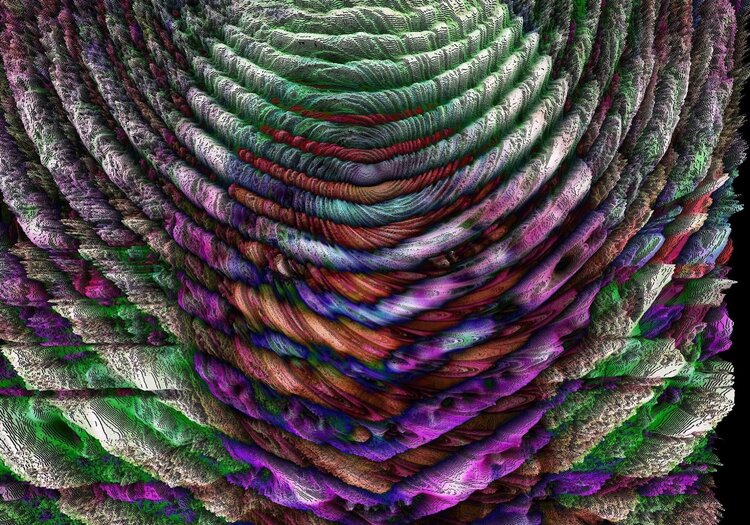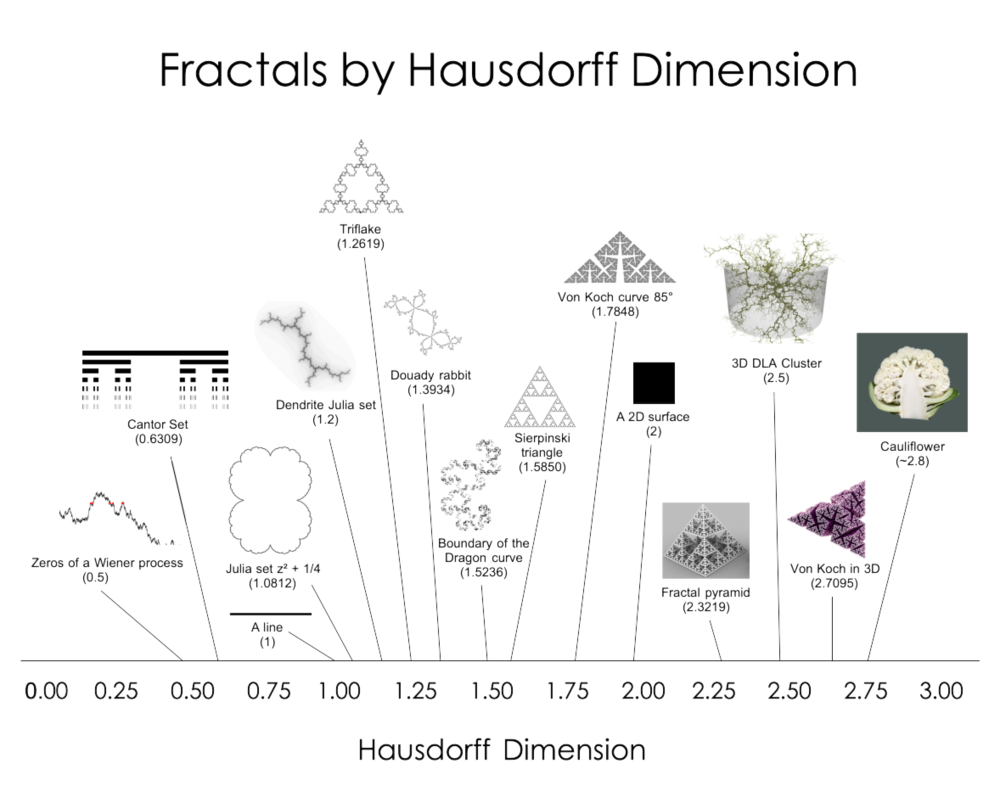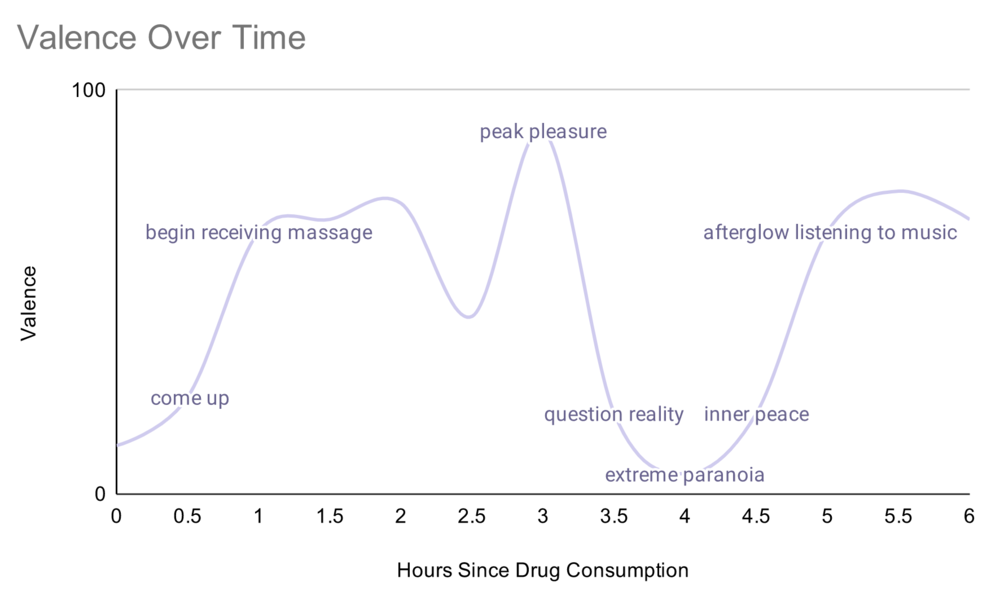Context: This is a guide to writing useful trip reports. If you read the trip report archives of Erowid, Bluelight, and PsychonautWiki, you notice a wide range of styles, interpretative lenses, and focus. We believe that a few relatively simple considerations can drastically improve the usefulness of written reports in ways that can open up novel research directions. This document is meant to extend and complement the Subjective Effect Index of PsychonautWiki in order to maximize the scientific utility of the written reports. If unconvinced of the importance of writing high quality reports, we recommend first reading David Pearce’s “Their Scientific Significance is Hard to Overstate”(Emilsson 2017a).
The first trip reports you write may not be very detailed, but you will improve over time. It is best to adopt a growth mindset when it comes to translating exotic forms of thinking into sober thinking others can understand. If learning to speak takes years and mastering a new human language in adulthood takes just as long, why would competence in translating psychedelic patterns of thought(Emilsson 2020c) be something you acquire on the first trip? Thus, it is no surprise that practice and patience are essential ingredients to becoming a psychonaut that is capable of sharing scientifically useful information to the world at large.
So how do you write a useful trip report? Let us start with perhaps the single most important instruction.
Focusing on the Phenomenal Character, Rather than on the Intentional Content of the Experience
The first and most important instruction is to focus on the phenomenal character as opposed to the intentional content of the experience. The intentional content of an experience is what the experience is about, whereas its phenomenal character is what it feels like. While it is worthwhile to discuss the content of your thoughts at a narrative level (e.g. you hallucinated being in an art museum where giant ladybugs were performing in a jazz quartet), the narrative alone will not be very useful to anyone. This is because a narrative description of what your trip was about drastically underdetermines what the experience felt like.
Hence, it is critical to enrich any narrative description with an account of the texture and structure of your experience. People often say things such as: “I went to DMT hell” or “I experienced an LSD paradise.” But what if you probe these statements further? What made the “DMT hell” so unpleasant? What made the “LSD paradise” so blissful? Most people, when asked, tend to be overly focused on saying things along the lines of:
“Well, I was meeting angels and strange creatures” or “there were people sobbing,” and they think that this explains why the experience was unpleasant or blissful. You have to understand that when explaining why a certain narrative felt a certain way, you cannot ultimately rely on more narrative. At some point, the explanation should be grounded by the texture of the experience rather than the experience’s narrative.1 Instead of those previous stories, we think a more useful description would be: “There’s this 3D matrix of resonance that created a lot of green-magenta Moiré patterns, and the sense of harmony and bliss seems to have come from that texture of my experience, and that texture is what made me interpret where I was as a kind of Heaven Realm.” The reason why the angels you saw felt so loving and benevolent comes down to the particular texture of your experience expressing that emotional palette. In other words, the angel is an expression of that sense of harmony and not the other way around.
An analogy is that if you’re listening to pleasurable music, you may hear guitar or piano sounds. The specific instruments definitely matter, but the bulk of what’s making the sound so pleasant and comforting may actually be the reverb quality of the music. Think of the angel like the sound of a guitar. The angel, like the guitar sound, has its own specific qualities (a certain vibe). But in addition to seeing an angel, your entire subjective experience contains this reverb pattern of reverberating (phenomenal) space-time(Emilsson 2018b). A phenomenal space-time that feels really wonderful will make you feel like you are in heaven.

Thus, we recommend that you pay attention to the nature of the phenomenal space and time you experienced and do two things:
- try to describe it in as much detail as possible in the language of frequency, dimensionality, fractality, reverb, etc.
- explain how the texture of the phenomenal space you inhabited influenced your emotions and semantic interpretations of what was going on.

Try to reverse-engineer the generators of your experience.
A very simple example would be if you were experiencing some kind of strobing effect, like seeing flickering lights. If so, it would be ideal to figure out the frequency of those lights. QRI developed a psychophysics tool to help people quantitatively measure(Emilsson 2020b) the visual effects of psychoactive substances. Ideally, you can use this tool while experiencing exotic state of consciousness (such as DMT or the states induced by a Fire Kasina(Emilsson 2020a) retreat), so that you can confidently report (for example) that you experienced a 20 Hz strobing effect.


Likewise, if you are experiencing replay effects and you enter a thought loop (cf. short-term memory tracers(Emilsson 2018a)), it’s very helpful if you can tell how big the loop is instead of saying “I was stuck in a loop.” Was the loop a fraction of a second or was it an elaborate narrative that you were circling around over the course of minutes? Those feel very different even though they are both technically thought loops.
Here is a very concrete example: imagine that your DMT trip looked like this(“Limitless - 2013 1st Place International Award Winning Laser Show,” n.d.) lightshow from 2:27 to 5:12.2
What would you say about it? A lot of people would become overly focused on explaining that at around 4:20, amazing lights felt like an angel, or that it was “richly colored and bright.” But the sort of information we believe is more helpful comes when you can point out simple and plausible ways the experience might have been constructed out of elementary building blocks. In this case, we refer you to one of the Youtube comments: “It is unbelievable that such a magnificent show could be made with just 5 lasers!” Indeed! Most people would be mesmerized by the light show, come up with some elaborate narrative for “what happened” and go about their day without ever realizing that the entirety of the visual content was generated by just five sources of light fixed in place the whole time! Now that is the sort of obvious-in-retrospect observation that can help us make tangible progress. For instance, it only took one clever math student to notice “oh dear, the walls of the DMT palace I’m in are tessellated by heptagons” to kick-start the explanation space where DMT’s odd effects involve an alteration to the curvature of phenomenal space and time (see: The Hyperbolic Geometry of DMT Experiences(Emilsson 2016b)). A lot of big insights start with seemingly innocent observations that are obvious in retrospect.
Examples of Statements That Do a Good Job Describing Phenomenal Character
The tracer effects clearly had replays equally spaced apart, calculated around 14hz with the tracer tool. I could make out three replays with precision, but there might have been four or five counting faint ones I couldn’t always see.
Whenever I would focus on my breath my visual field seemed to express a Kelvin–Helmholtz instability: thanks to tactile-visual synesthesia, the sensation of each breath would manifest as disturbances in my visual field, which in turn seemed to have a higher density than their surroundings, and this would give rise to turbulent flow very similar to the Kelvin–Helmholtz instability simulations I’ve seen online.
The left part of my visual field had a vertical wall I was attending to with peripheral vision. The wall felt like it was about 1 meter to my left and at a right angle. This hallucinated wall was vibrating at around 8hz and it had two alternating layers that looked about 1cm apart,3 one blue and one yellow. Their colors were alternating at about half the speed at which the wall was vibrating.
The ceiling was tessellated with a highly detailed texture organized along the 632 wallpaper symmetry group. More so, this tessellation was dynamic, in that all of the shapes were shifting and morphing. In sequence, a symmetry element type would be selected by attention (such as all of the copies of the 6-rotational symmetry element) and each repeating region of the texture in the entire ceiling would change by the rotation around the copy of the symmetry element that corresponds to it (example). Then another symmetry element would be selected and the pattern would morph by rotation around that new symmetry element, and so on. This lasted for about 1 minute and it faded as soon as I turned on some music.
By selecting features of my hallucinatory environment and attending to them, I could make them grow and in a way “reify them,” meaning that they would feel more and more real and vibrant the more I paid attention to them. I noticed that I could transform the walls of the hallucinated environment into glass walls with a peculiar property: when light goes through the wall in one direction it becomes lighter and when it goes in the other direction it becomes darker. This resulted in the room being filled with what I later recognized to be cohomology fractals(“Cohomology Fractals,” n.d.).
I was able to more easily separate the various “facets” of essential oils. In particular, rather than experiencing lemongrass as just a “unified block” (a single feeling of “herbal citrus scent”), I could break it down into three independent facets: a sharp citrus scent with peaks of sensation (probably citral or d-limonene), a soft and smooth alcoholic character impact background (probably neral and linalool), and an earthy almost clove-like spice face (probably centered around myrcene). It was noteworthy that these facets were far more cleanly separate than normal yet by focusing on any two of them at once I could blend them independently in a sort of “qualia chemistry.” It felt like each perfume in turn could be used to experience 5 or 6 different compositions depending on how I would attend and try to merge its different facets all inside of my mind!
My sense of time passing seemed to be constructed out of three distinct elements interacting with one another. One was based on the rate at which the color scheme evolved. The other two were based on the pulsing of visual sensations, which constructed the scene in a manner consistent with a temporal raster plot. The “vertical time” would take about two seconds to complete a cycle, whereas the “horizontal time” would be incredibly fast, doing perhaps a hundred cycles per second. The raster plot had adjustable height and width and this allowed me to visualize (much akin to an actual raster plot) how rhythms in my mind were coupled despite having frequencies at different orders of magnitude: the vertical direction would represent changes across hundreds of milliseconds whereas the horizontal direction would visualize rhythms going on at just a few milliseconds as long as they repeated for long enough.
The auralization of the sound loops I hallucinated would continuously and coherently transform in tandem with the 3-dimensional space group(“Non-Euclidean Auralization,” n.d.) I found myself in. This led me to interpret the auditory reverb effects as being consistent with the aggregate echo reflections inside a polygon in 3D hyperbolic spaces.
Personal Matters
Of course, psychedelic trips are intensely personal experiences. It is in the nature of psychedelic states to connect intellectual content with deep personal emotional processing. Nonetheless, when it comes to contributing to the commons with high-quality trip reports, you can lessen the impact of personal matters. Without ever mentioning that “it was about your grandmother,” you can just focus instead on the phenomenal character of your trip and provide the bulk of information to the scientific community. Of course, if there was something about the texture of the experience that made your emotional processing easier or harder, you should ideally point that out. But at no point do you need to delve into the specifics of your social circumstance.
Write It Like a Book
Think about the task of writing a trip report in the same way you would write a book report in middle school.4 The teacher assigns a book to read and then they provide a guide for writing your book report with the help of some basic questions everyone needs to answer. This is so that you do not forget to provide some of the critical information needed to interpret your report. We recommend reflecting on these questions and writing their answers before the trip so that your report of the set and setting that gave rise to the trip is not influenced post-hoc by the contents of the trip. Let’s apply this “write it like a book report” framing to reporting exotic experiences. Please provide:
Demographic Information
At the bare minimum, start by including basic demographic information:5 approximate age, gender, height, weight, genetics (national origin might be a good approximation, e.g. half-Mexican half-Icelandic), and health conditions.
Set and Setting Information
In addition to demographic information, make sure to include set and setting information: drug, dose, when it was taken, what method of intake was used (ingestion, smoking, etc.), social context, sleep deprivation status (well rested, just had a 20 minute nap after an all-nighter, etc.) how many times you have taken this drug and at what doses, time of the year, indoors/outdoors, and what the weather was like at the time.
After that, here are six basic questions that should ideally be addressed in every trip report:
1. Background Philosophical Assumptions
The most important thing is to start with clarity about what you believe. Most people have background beliefs that govern the way they think about reality even though they don’t really notice them most of the time. These assumptions will heavily influence what happens on a psychedelic trip. What are your background philosophical assumptions? What do you believe? Why do you believe what you believe? In particular, we suggest that you mention:
Recent Media Consumption
What people and media have influenced you the most? For example, recently reading a lot of Alan Watts books versus Richard Feynman’s Lectures on Physics may lead to very different experiences on LSD. Your recent media exposure cannot be neglected. And this is less about volume than about influence: you may have read a single quote a year ago that you still think about when showering while the daily consumption of your favorite television show is barely noticed by your subconscious. Therefore, share, most of all, how the media you’ve been consuming is influencing how you think about life, the universe, and everything else.
Direct vs Indirect Realism
Probably the most important belief to address is your stance on direct versus indirect realism about perception. If you read a lot of trip reports, many seem to be implicitly assuming direct realism about perception. This means that people believe they can access the world directly. When they see a flower breathe in and out, they may interpret this experience as the result of being given access to another set of frequencies of light or aspects of reality that we usually ignore. For example, Albert Hoffman seems to have thought about LSD in this way: in the last chapter of LSD: My Problem Child, Hoffman speculates:
“If one continues with the conception of reality as a product of sender and receiver, then the entry of another reality under the influence of LSD may be explained by the fact that the brain, the seat of the receiver, becomes biochemically altered. The receiver is thereby tuned into another wavelength than that corresponding to normal, everyday reality. Since the endless variety and diversity of the universe correspond to infinitely many different wavelengths, depending on the adjustment of the receiver, many different realities, including the respective ego, can become conscious.” One gets the impression that Hoffman really believed that LSD’s trippy visuals were revealing true information about the environment around us rather than telling us, perhaps, something about the way our brains construct a world-simulation we confuse for reality itself. This is not to say that one cannot in fact notice true details about the environment(Emilsson 2015) with LSD, but we can conceive of this as a trade-off between forms of attending to and processing the environment through our normal conventional senses rather than as being given access to new sense organs yet uncharted by science.
This is an important distinction. We should note that variants of direct realism about perception can be steelmanned to some extent. For example, you may look at a tree on a psychedelic and see a mythological creature embedded into the tree. When you come down, you can also verify it by observing that the tree actually kind of resembles the creature you saw on your trip and shows up when you’re not tripping. Once you notice that sort of thing, you cannot unsee it. And maybe other sober people might also see it too once you point it out. In other words, psychedelics will very likely, within some parameters, allow you to see patterns in the real world that you may be missing out on otherwise. It doesn’t mean that you’re perceiving the world directly through a new sense organ. It just means you’re processing that information in a slightly different way.
We would generally suggest to approach a trip report with an indirect realism mindset, where you assume, until proven otherwise, that you are experiencing states of your own internal world-simulation. This allows you to have much better clarity about many strange phenomena. For example, if you feel that you are somehow entangled with your environment, you would in this lens interpret that feeling as an entanglement with yourself. You are just entangled with a part of yourself that you usually interpret as being the external environment.
Indeed, one of the trickiest things about life that we don’t realize for the most part is that the very sense of an external environment itself is part of your internal world-simulation.6 So for your trip report, make sure to point out if you are interpreting your experience through this lens, the lens of direct realism, or perhaps a hybrid lens (where some aspects are perceived directly and some aren’t).
2. Emotional and Cognitive State
What is your background emotional and cognitive state like? What is your preferred cognitive style? For example, do you naturally have a high baseline well-being or are you more melancholic? Do you identify as a people person or are you a mathematician with no interest in people?7 It’s actually quite important to note and can result in quite different experiences.
Observing Your Emotions
Paying attention to how emotions are expressed on psychedelics is one of the most important things you can do. People regularly project their emotions onto the nature of reality. Be mindful of this as a failure mode. It’s helpful advice both for better phenomenology and psychologically to try to notice the way emotions manifest in your world-simulation. Emotions will be modifying the way your attention is directed, and noticing this can allow you to gain some control over this process. You can tell the difference between physical suffering and mental suffering in terms of whether these patterns have dissonance(Emilsson 2017b)8 located in your (phenomenal) body or in the part of your experiential field that represents thoughts.
It sounds kind of strange. When we’re caught up in mental suffering, we usually don’t realize that it’s a type of unpleasant sensation or dissonance. It is not ineffable. There’s actually a location, region, or subcomponent of the phenomenal field that is vibrating in a strange and unpleasant way. In many ways, noticing how emotions modify the structure of either your felt-sense of your body or your thought patterns will prevent you from being controlled by the emotions without you knowing it.
It’s very important to notice this, and noting this can be helpful for avoiding a bad experience. Often, the reason why you feel terrible in your psychedelic state is not because you realized a big, deep truth about reality or due to anything bad you did. It is frequently the case that you entered some kind of dissonant attractor, and there’s probably a way out of it.
Often, one is advised to “let go and embrace whatever is happening.” This advice does allow you to reduce that dissonance and lessen the grip that mental or physical suffering has on you. It allows you to let it just vibrate on its own for a while without you feeding it energy. And that is helpful. We think it’s even more helpful if you can diagnose the source of dissonance and address it directly. Thus, at an even deeper level, “disengage from dissonant patterns” is better advice than “just let go” because there are some states where letting go is actually a bad idea. If you’re actually very close to making a psychological or intellectual breakthrough, letting go is probably not optimal. Instead, have the mindset of being gentle to yourself by letting go of the dissonant component of the experience rather than its intentional content.
3. Temporal Progression
What was the overall temporal progression of the experience? Draw a graph where the x-axis is time and the y-axis is a variable you want to track, such as “intensity of effects,” “brightness of visual field,” or “emotional valence” and update the graph every half hour. This will help you remember where you were at each stage of the trip and allow you to place your thoughts and ideas along the timeline.
Right after the trip, spend some time making sense of the general structure of what you experienced. That is, identify what kind of arc or main stages the trip involved. Outline how your beliefs and emotions changed throughout each of the stages. Try to recall how long each physical hour felt like9 (e.g. “1st hour felt like 90 minutes, 2nd hour felt like two hours, 3rd hour felt like two hours, etc”).

4. The Theme
Was the trip primarily philosophical, self-introspective, investigative, or focused on emotional processing? Go into as much detail as you feel comfortable. Obviously, there are going to be very personal things, so record only as much as feels comfortable or useful to you.
5. Valence
What did you learn about valence? What was the connection between the way the trip unfolded, the quality of each level, and the various thoughts and feelings? How did those contribute to a sense of well being, despair, or neutrality?
We’re very interested in confirming the idea that it feels really good when all your attention centers are synchronized and flickering at the same frequency(“5-MeO-DMT: A Rational Analysis at Last,” n.d.). If that was the case, then please let us know. If it wasn’t, also please let us know!10
6. Qualia and Binding Patterns
In what way did the trip allow you to experience qualia that you have never experienced before (like impossible colors(Helmenstine 2017))? Let’s say that you experienced a new combination of touch and auditory sensations. This is really significant! Don’t overlook it, note it down! During the trip, if you’re experiencing new qualia, do as much as you can to explore and investigate it by testing when it arises, when it dissolves, and what actions, if any, can multiply or intensify it.
Buddhists have names for a lot of the novel qualia that arise during meditation. One of those is equanimity. Equanimity feels like something; it’s not just a word. There’s actually a facet of experience that corresponds to it.11 Likewise, on psychedelics you probably experience a ton of new qualia. We need a glossary for uniquely-psychedelic qualia!
In addition to novel qualia, notice and report any novel patterns of binding. This is about how sensations become coupled together or dissociate in unexpected ways—how sensations are linked together in phenomenal time and space to form coherent phenomenal objects. A special case of “exotic patterns of binding” is synesthesia, where two or more of the sensory modalities become coupled together (such as experiencing phenomenal objects that are sound-touch hybrids). But patterns of binding can also be exotic even when they are expressed within the same modality, such as how the visual field seems to acquire extra virtual dimensions on DMT. We would also consider alterations of the sense of space and time as the result of exotic patterns of binding. So, this is a very general effect with many possible manifestations. If you notice anything of this sort, pay attention to it! How were your sensations bound or unbound in ways that are unusual? Be as detailed as possible.
A Meta Consideration
We suggest that you do not get caught up in the obligation to report things during the experience. Or worse, to believe that in order to be a good trip reporter you have to be able to write everything in real time. Trying to write your trip report in real time is likely to make you feel quite miserable! This is because whether we like it or not, we derive a lot of our self-worth from our feeling of verbal competence. So when you are under the influence of something as powerful as LSD and your verbal skills break down, the feeling that you “are not yourself anymore” gives you a sense of personal failure. But this will only arise if you begin your trip with the expectation that you will be able to report on it in real time. Instead, acknowledge that you will probably be terrible at verbalizing on psychedelics and instead focus your energy on remembering the properties of the state in non-verbal ways. Don’t feel compelled to write extensively because that’s going to be difficult. Just take note of the time or make a drawing or mark that you will understand later.
We do recommend recording the experience as much as you can (short of showing yourself on camera handling or consuming the chemical… don’t do that!). Recording the entirety of your experience unobtrusively in the background may be really helpful for reconstructing what happened afterwards. We have heard that not doing this is a common regret, especially for trips involving high doses where you genuinely wonder what was happening around you in consensus reality (if anything, the footage will help ground you in the certainty that at least the God that visited you wasn’t emitting regular photons that were visible to other people in the room). If you’re comfortable with it, leave at least an audio recording on.
We encourage you to record any important ideas, especially if you suspect that there’s any chance you may forget them. Take your insights seriously. They matter. Don’t feel that you lack the qualifications nor the background for your insights to matter. You are in a very exotic state that’s largely unexplored. What you are experiencing probably matters immensely for the collective understanding of humanity.
Additional Resources for Writing High-Quality Trip Reports
If you’d like some inspiration, here are examples of great trip reports:
And here are more resources for trip reports and strengthening your phenomenological skills:
- QRI developed a psychophysics tool to help people quantitatively measure the visual effects of psychoactive substances.
- Psychonaut Wiki, Effect Index
- Psychedelic Information Theory by James Kent
- The Grand Illusion by Steven Lehar
- Algorithmic Reduction of Psychedelic States
- The Hyperbolic Geometry of DMT Experiences: Symmetries, Sheets, and Saddled Scenes / Explain Like I’m Five Version
- A Language for Psychedelic Experiences: Algorithmic Reductions, Field Operators, and Dimensionality
Acknowledgments
Special thanks to Mackenzie Dion and Andrew Zuckerman for their feedback, suggestions, and copious edits to this document.
Tags
In fact, we would claim that the mechanism by which “seeing people sob” feels sad can be explained by how this narrative element influences the texture of your experience.↩︎
Beware that it is very loud right before 2:27.↩︎
The ideal units to report would be degrees, depth, and location within one’s visual field. In practice, most people will be better at reporting estimates of distances gauged as if they were physical distances out there in the world. In the future we will provide conversion tables to unify the units of phenomenological reporting↩︎
Thanks to Ryan Ragnar for providing the analogy between trip reports and middle school book reports.↩︎
Skip demographic data if you do not feel comfortable sharing it. It will be helpful in order to identify idiosyncratic responses to psychedelics and other compounds, but privacy is also very important. Share approximate information if that makes you feel more comfortable (e.g. “between 20 and 25 years old” rather than “21 years and 3 months old”).↩︎
Steven Lehar’s “Cartoon Epistemology(Lehar 2003)” provides a great visual demonstration and argument for indirect realism about perception.↩︎
See: empathizing-systemizing theory, autism spectrum quotient, systematic empathy(Emilsson 2016a).↩︎
Dissonance emerges when two incompatible patterns of resonance try to interact with one another. See Principia Qualia(johnson2016principia?) and Quantifying Bliss for an in-depth discussion.↩︎
Physical time being the objective passage of time according to clocks in consensus reality, whereas phenomenal time is how the passage of time feels like in a given experience.↩︎
In particular, pay attention to the temporal and spatial frequency of synchronized patterns, and whether there are competing patterns that cause dissonance with one another (for more, see: Symmetry Theory of Valence: 2020 Presentation(Emilsson 2020d) and Why Does DMT Feel So Real?).↩︎
See Mike Johnson’s interview of Shinzen Young for a discussion on the way equanimity feels.↩︎